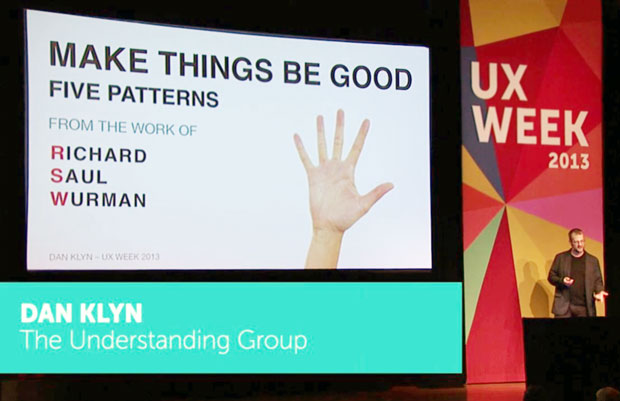I had the pleasure of hearing Dan Klyn’s lecture at UX Week in San Francisco recently, where he shared his work in decoding the relationship between Richard Saul Wurman’s ideas on architecture, design, and how we structure information. Klyn claimed that what he found in Wurman’s work goes beyond information architecture, and even UX–that he defined a way of thinking, living life, and “making things be good.”
Klyn identified at least five patterns in Wurman’s work that describe this way of thinking and can be tools for UX designers today: 1. Order encodes meaning, 2. What before how, 3. Apperception, 4. Terror and confidence, and 5. Expertise expires.
In this post, I will focus on “What before how,” a concept that was best illustrated in Wurman’s architecture project, Sandcastles.
But first, a story: Problems with information and language
In 1976, Wurman was the chairman of the American Institute of Architects and gave a presentation at its national conference. This presentation, more fable than slide deck, tells the story of a fictional town in which its inhabitants are only able to describe their needs using the words “more” and “no.”
Wurman’s character in this tale, the commissioner of curiosity, travels across town investigating the problems faced by its residents. In response to the town’s architectural despair, Wurman summarizes that, “The problems in the architecture of the built environment are due to the problems in the architecture of information and language.”
When the commissioner of the town asks a teacher how education could be improved, she said they need more books, more classrooms, more pencils. A policeman replied that they needed more jail cells, more cops, more bullets and bullet proof vests. The commissioner realizes that the reason why the town’s citizens cannot be satisfied is that they lack the language necessary to describe their needs–they’re only describing solutions using “more” and “no.”
It’s a problem we deal with everyday: Wurman’s Sandcastles
In 1970, Wurman and his architecture firm designed and developed four vacation homes on Long Beach Island, New Jersey. Wurman called them Sandcastles, and only one of them still stands today. Three homes were constructed in place of the fallen sandcastles, each an amalgamation of the styles of neighboring homes and generic New England architecture.
In response to this unfortunate turn of events, Klyn asks, “How do we account for the significant differences between sandcastles and whatever… this is?”
It becomes clear that their replacements were built with a focus on “more” and “no.”
What does this mean for UX today?
As a designer in any field, we are often faced with the challenge of defending our ideas against the onslaught of more’s and no’s. At times, we may even find ourselves gravitating toward the easy answers that this approach often provides us. Wurman put it best when he said, “The classic, pervasive seduction to designers has been to find a solution instead of the truth.”
The best defense against this seduction is a willingness to invest in defining “why” before “what.”
I believe that the field of user experience is a reaction to this sentiment. It’s a paradigm shift in the way we design for software, web, and beyond. We are lucky to participate in a time where the world is becoming more conscious of this idea, but the responsibility lies on us as designers to hold up our end. We must work harder than ever to prove to those around us that investing in understanding is requisite to creating honest and truly helpful solutions for people engaging with technology.
Our toolkits have never been more fully realized so we have the opportunity to take advantage of techniques such user research, testing, prototyping, and others that so many before us have worked to refine. We are also fortunate that, unlike the physically built environment, we have more opportunity to iterate on and improve our solutions through understanding people and their contexts.
